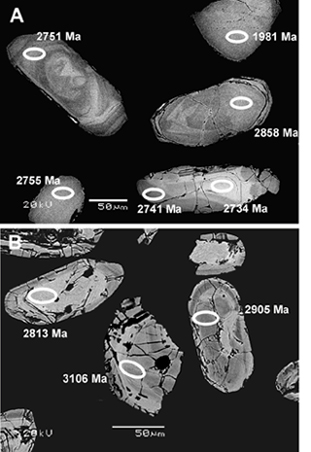 A team of
Finnish geologists has discovered 3.1 billion-year-old zircons in the Jormua
ophiolite of eastern Finland. Although not the oldest zircons on Earth (4.4
billion-year-old continental zircons have been found in Western Australia),
the Jormua zircons are the oldest yet found in mantle rocks. Their discovery
has given scientists a brief glimpse into the history of early plate tectonics.
A team of
Finnish geologists has discovered 3.1 billion-year-old zircons in the Jormua
ophiolite of eastern Finland. Although not the oldest zircons on Earth (4.4
billion-year-old continental zircons have been found in Western Australia),
the Jormua zircons are the oldest yet found in mantle rocks. Their discovery
has given scientists a brief glimpse into the history of early plate tectonics.
The zircon samples were analyzed at the Laboratory for Isotope Geology at the Swedish Museum of Natural History in Stockholm using NORDSIM, an ion microprobe jointly owned by all Nordic countries. Shown here are backscattered-electron images of zircons from two separate clinopyroxenite mantle dikes of the Jormua ophiolite, with sample spots and derived ages noted. Courtesy of Geology.
According to a paper published in the July Geology, the zircons indicate that the mantle must have been cool and stable by 3 billion years ago, more than 500 million years sooner than a standard theory of mantle evolution predicts. It also tells geologists a little more about the local tectonics of the Jormua ophiolite, a rare fragment of ancient seafloor emplaced on a continent, as well as the Karelian craton, a precursor to today’s Fennoscandian shield.
“The preservation of Archean zircons in the Jormua mantle fragments provides evidence that there was a relatively stable and cool mantle root below the disrupted craton from 3.1 billion years ago until its breakup circa 1.95 billion years ago,” says geologist Asko Kontinen of the Geological Survey of Finland. He is a co-author of the Geology study with colleagues Petri Peltonen, Irmeli Mänttäri and Hannu Huhma.
The suggestion that continents already had thick, relatively cool, nonconvecting roots by 3 billion years ago runs contrary to currently accepted theories of mantle evolution. These hold that a major shift in mantle convection occurred around 2.5 billion years ago at the Archean-Proterozoic boundary. During the Archean (between 4.0 billion and 2.5 billion years ago), mantle convection is thought to have been rapid and shallow, forming only small tectonic plates, called microplates or protocontinents. Then at the beginning of the Proterozoic, the mantle ostensibly underwent thermal changes that established much larger convection cells that drove the formation of larger continental plates, in processes similar to modern plate tectonics.
However, the Geology paper and other recent studies of the Jormua ophiolite have indicated that these processes may have already been at work under the Karelian craton by that time.
Recent mapping of the ophiolite revealed that its western block lacked something the other blocks had — oceanic crustal rocks. Researchers found the western block was exposed mantle, shot through with alkaline dikes, similar to continental massifs and mantle xenoliths found elsewhere. Researchers previously thought it was a more typical ophiolite, consisting of oceanic crust and oceanic mantle. Other research had also questioned the geotectonic setting in which the ophiolite formed.
“Basically what we report strengthens the inference that the mantle unit of the Jormua ophiolite complex would consist mainly of Archean subcontinental lithospheric mantle,” Kontinen says. “This in turn strengthens the inference of the complex as formed in conjunction with continental breakup in a geodynamic environment akin to that of the present Red Sea.”
Kontinen and colleagues theorize that a rift similar to the one found in the Red Sea today began to split the Karelian craton about 1.95 billion years ago. The crust thinned and stretched, magma intruded the crust forming sheeted dikes under the spreading center, and new oceanic crust began to form. However, the stretching was asymmetric, exposing parts of the continental mantle under the rifting crust. The Jormua ophiolite became emplaced when this section later collided with a continent. “Finding the zircons fits well in the picture,” Kontinen says.
The zircons found in the ophiolite were present as foreign inclusions in much younger Proterozoic ultramafic-mafic dikes. Researchers believe that the dikes intruded into the upper mantle about 1.95 billion years ago just as the craton begin rifting. The magma in the Jormua dikes formed in deeper, hotter mantle and traveled up to become emplaced in shallower, cooler mantle.
During ascent, “the intruding Proterozoic dikes grabbed zircons from the surrounding mantle rocks,” which were similar to, yet much older than, the rocks in which they were found, Kontinen says.
The relatively narrow dikes would have cooled quickly. Had the zircons been heated at temperatures close to 1,000 degrees Celsius for more than several million years, the zircons’ isotopic age could have been reset. But because the grains cooled quickly, the uranium-lead isotopic clock of the zircons continued to maintain the age of their last crystallization, 3.1 billion years ago. Thus, the researchers have an upper limit on the temperature conditions that the zircons have been subjected to since then.
Because exposures of such ancient oceanic crustal sequences are rare, any insight into ophiolite stratigraphy is valuable to scientists who study early tectonics. Only about five ophiolites in the world are greater than 1.6 billion years old. In contrast, the oldest current seafloor is just 170 million years old and most likely buried beneath a thick layer of deep-ocean sediments.
“Jormua provides one rare window into the nature of Precambrian mantle,” Kontinen says. “There is clearly much potential for further study of the Jormua ophiolite to get invaluable evidence of both Archean and Palaeoproterozoic mantle processes.”

